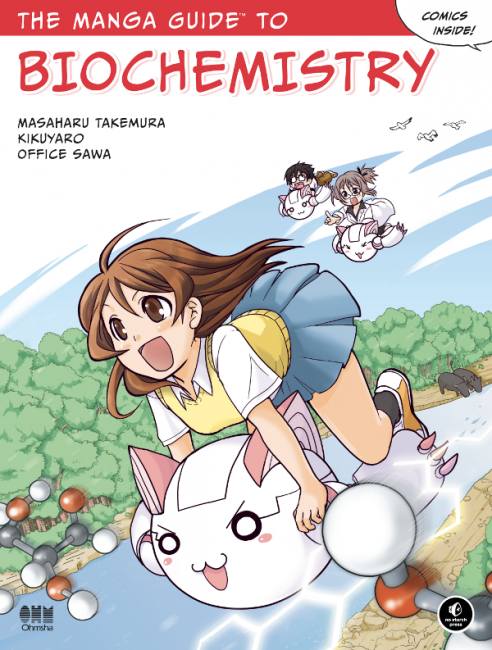I was looking forward to No Starch Press’ latest Manga Guide release for months before it actually came out. I quite enjoyed The Manga Guide to Molecular Biology, and thought this would make for an excellent companion piece. Obviously I wasn’t the first person to think so, the author of that previous book, Masaharu Takemura, must have felt the same or he wouldn’t have agreed to write this one as well.

Biochemistry and molecular biology are like solid state physics and physical chemistry or, if you like, psychology and sociology. Both disciplines find themselves interested in many of the same phenomena, but consider slightly different aspects of each one.
Molecular biology is interested in how the body works as a system on the sub-cellular level. The basic processes of life are considered with respect to how they manage to maintain all the functions of a cell. Biochemistry is interested in all the chemical behaviour involved in life, which ultimately is responsible for all those same cellular functions.
Both books discuss many of the same ideas, therefore, but there’s virtually no overlap in content. In Molecular Biology, enzymes were considered as helpers in chemical processes. In Biochemistry, more time was spent on the specific reactions they catalyzed, and the actual chemical structures of reactants and products. Both books discuss the way DNA information is read and translated into specific proteins, but biochemistry goes into the chemical detail of DNA, RNA, and the amino acids that make up a protein and determine its folding.
 The storyline is cute: Kumi is a teenage girl constantly worried about her weight. She decides to study biochemistry so she has a better understanding of her metabolism and its relationship to weight gain. This is not just an entertaining framing device; Takemura is intentionally using a non-traditional approach to the topic, introducing major chemical characters into the narrative in an organic way as they become relevant to particular chemical processes.
The storyline is cute: Kumi is a teenage girl constantly worried about her weight. She decides to study biochemistry so she has a better understanding of her metabolism and its relationship to weight gain. This is not just an entertaining framing device; Takemura is intentionally using a non-traditional approach to the topic, introducing major chemical characters into the narrative in an organic way as they become relevant to particular chemical processes.
Proteins, fats (lipids), and carbohydrates (saccharides or sugars) are each discussed in different chapters. The chapter on carbs isn’t really just about carbs, it’s about how sugars are used to create ATP which in turn provides energy for the cell (amongst many other things). The chapter on proteins isn’t just about the Atkins diet, it’s also about how enzymes are created and how they function as biological catalysts.
This isn’t the first Manga Guide to take a non-traditional approach to a topic. Calculus took a much more intuitive, less mechanical approach to derivatives and integrals, though not a less rigourous one. Universe followed a historical sequence in discussing the heavens, steadily overturning pre-conceptions as contradictions were discovered. And all of the books in this series have emphasized real-life examples and applications, whatever the topic. The chemical reactions discussed in the book are used to explain everything from the ripening of fruit to the springiness of mochi-style rice.
And it works. There are a number of topics in science that are frequently taught a certain way because it makes it easier to organize a textbook, or faster to “cover” in class, even though it’s not the most efficient approach to actual learning. I appreciate this series’ willingness to eschew traditional learning sequences in favour of intuition, learning in context, and developing ideas organically from previous knowledge. Another enjoyable entry to the series.
(No Starch Press, 2011)
Reprinted with permission from The Sleeping Hedgehog
Copyright (2012) The Sleeping Hedgehog